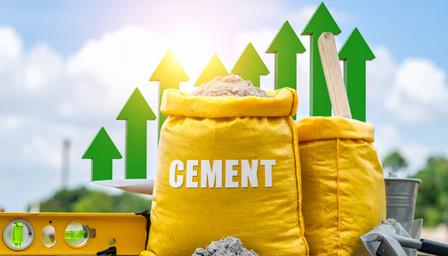GST Reforms To Boost Operating Profit Of Cement Companies By Rs 100-150 Per MT In FY26
The government move will also reduce overall construction expenses in rural housing by 0.8-1 per cent, boosting volumes and supporting enhanced capacity addition.
Backed by the healthy cement demand, average cement realisation (ex-factory price excluding GST) is expected to rise by 3-5 per cent in FY26, even as the input prices are expected to remain range-bound, credit rating agency ICRA said in its report.
Further, Operating Profit Before Interest, Taxes, Depreciation, and Amortisation (OPBIDTA) is likely to improve by 12-18 per cent to Rs 900-950/MT in FY2026, it added.
Cement volumes increased by 8.5 per cent in 5 months of FY26 due to strong demand from the housing and infrastructure segments, despite the early onset of the monsoons in a few regions.
Cement prices have increased by 7.4 per cent in the first five months of the current fiscal on a year-on-year (YoY) basis, with major hikes in the northern and eastern regions.
The trajectory of input prices, especially for pet coke and freight, is linked to global crude, which remains exposed to geopolitical dynamics.
With the recent GST rate cut from 28 per cent to 18 per cent expected to be passed on to customers, and the average retail price of cement currently ranging between Rs 350–360 per bag, consumers are projected to benefit by Rs 26–28 per bag, the report said.
According to the report, in FY25, the OPBIDTA/MT had declined by 16 per cent YoY due to weak realisations (especially during H1 FY2025, because of extended monsoon and impact on Government capex amid the General Elections).
Overall, the credit profile of large cement producers is expected to remain stable, driven by a healthy growth in operating income, expected improvement in operating margins and comfortable leverage metrics.
The industry has witnessed consolidation in recent years, and the performance of larger players is expected to outperform compared to that of mid-size players in the medium term.
“ICRA estimates green power to account for 43-45 per cent of the total power mix by March 2026, compared to around 35 per cent as of March 2023, for the cement companies in ICRA's sample set," said Anupama Reddy, Vice President and Co-Group Head, Corporate Ratings, ICRA.
The major cement players in the country aim to reduce their emissions by 15-17 per cent over the next 8-10 years by increasing the share of blended cement, which uses less clinker and consequently less fuel, boosting the share of green power consumption through a mix of solar, wind and waste heat recovery system (WHRS) capacities, Reddy added.

Legal Disclaimer:
MENAFN provides the
information “as is” without warranty of any kind. We do not accept
any responsibility or liability for the accuracy, content, images,
videos, licenses, completeness, legality, or reliability of the information
contained in this article. If you have any complaints or copyright
issues related to this article, kindly contact the provider above.
Most popular stories
Market Research

- Kucoin Partners With Golf Icon Adam Scott As Global Brand Ambassador
- Mediafuse Joins Google For Startups Cloud Program To Scale AI-Driven, Industry-Focused PR Distribution
- Solotto Launches As Solana's First-Ever Community-Powered On-Chain Lottery
- 1Inch Unlocks Access To Tokenized Rwas Via Swap API
- Leverage Shares Launches First 3X Single-Stock Etps On HOOD, HIMS, UNH And Others
- Forex Expo Dubai 2025 Returns October 67 With Exclusive Prize Draw Including Jetour X70 FL





















Comments
No comment